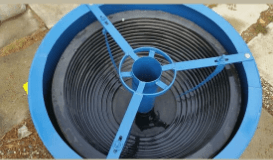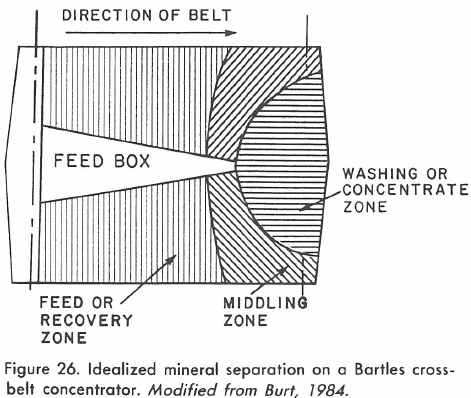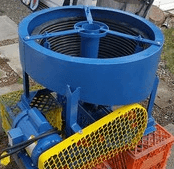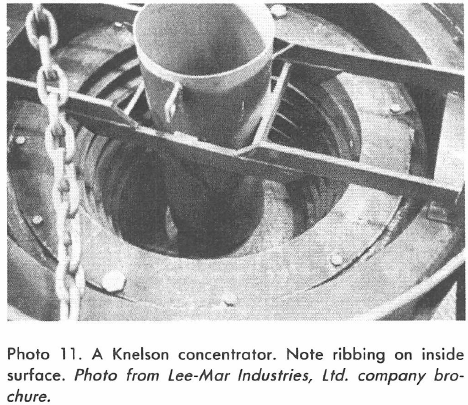 Bowl concentrators have been used only to a limited extent in small placer operations. The two most popular designs were the Ainlay and Knudsen bowls. There is little difference in design and operation between the two, except for riffle design and minor variations in bowl size and shape. They were used primarily as cleaners, but have fallen into disuse due to the availability of more efficient equipment.
Bowl concentrators have been used only to a limited extent in small placer operations. The two most popular designs were the Ainlay and Knudsen bowls. There is little difference in design and operation between the two, except for riffle design and minor variations in bowl size and shape. They were used primarily as cleaners, but have fallen into disuse due to the availability of more efficient equipment.
Generally, the typical bowl concentrator is a basin 12 to 36 inches in diameter at the rim, lined with rubber riffles along the inner surface. The bowl is mounted on a vertical shaft, which spins at over 100 rpm. Material smaller than 3/8 inch down to 1/8 inch is fed with wash water into the bottom of the bowl. The centrifugal force of the spinning bowl causes a film of material to travel upward along the inside of the bowl. The heavy material catches underneath the riffles and lighter particles are washed out over the rim. When the riffles are full, feed is shut off and the concentrate is washed out. Capacities range from ½ to 5 cubic yards per hour (roughly equal to 1 to 8 tons per hour), depending on the size of the bowl. The larger bowls require up to 30 gallons of water per minute for processing.
The main advantages of bowls are reduced power consumption and less water use than comparable equipment. On the negative side, however, recovery of gold can decrease as a result of the compaction of concentrates in the riffles. In addition, frequent cleanups, which require haltS in operation, are required. The availability of more efficient equipment limits the widespread use of bowl concentrators.
Centrifugal concentrators have been in use since the early days of mineral processing. Although centrifugal devices were never extensively used, recent innovations may make their use more widespread. In this section, which is by no means comprehensive, the bowl concentrator and the new Knelson concentrator are described.
The Knelson hydrostatic concentrator is a centrifugal bowl-type concentrator. The unit is essentially a high speed, ribbed, rotating cone with a drive unit. Ore slurry containing 25% solids is fed into the bottom of the unit. As with bowl concentrators, concentrates are retained in the cone until cleanup, while tailings are continually washed out over the top. There are currently five models available, ranging in size, as measured at the diameter of the cone, from 7.5 inches to 30 inches. These units have capacities from 1 to 25 cubic yards per hour. All models require less water than a conventional sluice and take up very little space. The largest model takes up a 5-foot cube of space and can be mounted on a trailer for portability.
The Knelson concentrator utilizes the principles of hindered settling and centrifugal force. A central perforated cone containing horizontal ribs welded along the inside wall is rotated at 400 rpm, at which speed it generates a force of 60 g. Heavy particles are forced out against the walls and are trapped between the ribs (Photo 11). Lighter particles are carried by the water flow out the top. The cone is surrounded by a pressurized water jacket that forces water through holes in the cone to keep the bed of heavy particles fluidized. The force of the water acts against the centrifugal force of the rotating cone. This counterforce is strong enough to inhibit severe compaction of the collected concentrate. As a result, the mineral grains remain mobile, allowing more heavy particles to penetrate. As processing continues, lighter particles in the mobile bed are replaced by incoming heavier ones, until only the heaviest particles in the feed are retained. Cleanup is accomplished by stopping the cone, opening a drain at the bottom, and flushing out the concentrate. This is usually done at the end of a shift.
Apparently, this process is very efficient. Tests conducted by CSMRI and others have produced consistent gold recoveries above 95%. In Alaska, ore samples from mining properties were processed using Knelson concentrators. In one case, material originally evaluated at $5.00 a cubic yard yielded over $12 a yard in recoverable gold when tested with a Knelson concentrator. In a second case, the recoverable gold value increased from $3 to $30. According to CSMRI tests, the machine has recovered gold as fine as 38 microns (400 mesh) (Spiller, 1983; McLure, 1982).
The Knelson concentrator is an efficient, portable machine with a number of advantages. The unit uses less water than conventional sluices. The amount of concentrates saved is small (around 5% or less of the initial feed weight); so final cleanup is easier. The concentrator is portable and easy to use, and it efficiently recovers fine gold. It is relatively inexpensive and requires little maintenance. The smaller machines are suitable for exploration or mineral concentration for small placer deposits. Depending on size, these devices are suitable for use as roughers, cleaners and scavengers. The Knelson concentrator should be seriously considered when purchasing recovery equipment.
